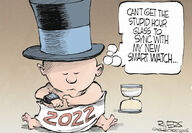Sorted by date Results 126 - 150 of 211
The 70th anniversary of the Supreme Court’s landmark ruling in the Steel Seizure Case reminds us of the capacity of the nation’s High Tribunal to stand tall in the defense of the rule of law and American Constitutionalism. On 2, 1952, the court, in the extraordinary case of Youngstown Sheet & Tube Co. v. Sawyer, reined in executive authority when it declared unconstitutional President Harry S. Truman’s assertion of “inherent power” to seize the nation’s steel mills to prevent a strike that he feared would imperil America’s conduct of th...
Fifty-five years ago, on June 12, 1967, the U.S. Supreme Court, in the landmark case of Loving v. Virginia, struck down in the name of equal protection and due process a state law banning interracial marriage. The court declared that the right of marriage, though nowhere mentioned in the Constitution, is a fundamental right, the exercise of which is protected by the 14th Amendment. The court’s unanimous opinion, written by Chief Justice Earl Warren, represented a powerful blow to one of the remaining remnants of Jim Crow and Virginia’s eff...
It is fair to say that the government’s preeminent responsibility is to provide for the nation’s defense. When necessary, civil liberties protected by the Bill of Rights must yield to the demands of national security. In Minersville v. Gobitis (1940), the Supreme Court, over assertions of religious liberty by Jehovah’s Witnesses, upheld a Pennsylvania state law requiring school children to salute the flag on the theory that the pledge of allegiance promotes national unity and national unity protects national security. The Gobitis Court...
In 1940, in Minersville v. Gobitis, the Supreme Court upheld a state law requiring school children to salute the flag, despite religious objections by Jehovah Witnesses, who said the statutory requirement violated their religious liberties under the Free Exercise Clause of the First Amendment. Three years later, on June 14, 1943, in West Virginia Board of Education v. Barnette, the court changed its mind and, in a landmark opinion, held that school children have a constitutional right to refuse to salute the flag. What was the court thinking? W...
In 1962, in Engel v. Vitale, the U.S. Supreme Court, in one of the most controversial decisions of the Warren Court era, held school-led prayer unconstitutional for violating the First Amendment’s Establishment Clause. Engel was the first school prayer case heard by the court, but it was not starting from scratch in considering the issue of governmentally sponsored religious practices. The court had previously upheld against the assertion of an Establishment Clause violation a state program that involved busing children to parochial schools. I...
The U.S. Supreme Court’s first major ruling on the meaning of the First Amendment’s Establishment Clause was in Everson v. Board of Education, in 1947, when it upheld a state law that provided busing of students to parochial schools. The court’s entry into this constitutional maze foreshadowed the controversy that surrounds - to this day - governmental acts and programs that promote religion. At issue in Everson was a New Jersey statute that authorized local school boards to reimburse parents, including those whose children attended Catho...
In his unanimous opinion for the Supreme Court in the watershed case of Brown v. Board of Education (1954), Chief Justice Earl Warren asked the foundational question: “Does segregation of children in public schools based solely on race, deprive Black children of equal educational opportunities?” He answered: “We believe that it does.” Therefore, the court held, segregation violates the 14 th Amendment’s Equal Protection Clause. As Chief Justice Warren explained, the separation of children “solely because of their race generates a feeling of...
“If it was not the most important decision in the history of the court,” Justice Stanley Reed observed of Brown v. Board of Education, “it was very close.” The Supreme Court’s opinion in Brown, delivered on May 17, 1954, held segregation in public schools unconstitutional, a decision that paved the way for the removal of racial discrimination from American law. By any measurement, the ruling placed Brown in the pantheon of America’s greatest judicial decisions. Justice Reed, the last of the three Southern members of the court to join Chief...

President Dwight D. Eisenhower's recess appointment of Earl Warren to the chief justiceship of Supreme Court on September 30, 1953, constituted a watershed mark in the history of the court. His leadership of what was decidedly the Warren Court, generated more landmark opinions in American constitutional law than any chief since John Marshall. Chief Justice Warren, it has been rightly said, did more than any jurist in our nation's history to ensure that the law, in W. H. Auden's phrase, "found...

The Supreme Court's landmark ruling in the case of Brown v. Board of Education, the most-celebrated civil rights decision in our nation's history, is a reminder of the unpredictable twists and turns that shape American constitutional law. On May 17, 1954, the court held that racial segregation of children in the public schools violated the Equal Protection Clause of the 14th Amendment. The court's denunciation of the separate-but-equal doctrine, which had provided the legal foundation for...

Justice John Marshall Harlan was the only dissenter from the U.S. Supreme Court's infamous ruling in Plessy v. Ferguson, in 1896, in which the majority invoked the "separate but equal" test to uphold segregation laws. Justice Harlan's immortal dissent became law in the landmark case of Brown v. Bd. Of Education of Topeka, Kan. (1954), in which the court overturned Plessy and held that "separate but equal" was inherently unconstitutional and a violation of the 14th Amendment's Equal Protection...
Not all landmark Supreme Court decisions are admirable. Some are frankly infamous, including Plessy v. Ferguson. In 1896, in Plessy, the court constitutionalized racial segregation in the South. The court’s opinion plundered Black Americans’ newly confirmed rights “guaranteed” by the 13th and 14th Amendments, relegated them to second-class citizenship and imposed a legal stamp of inferiority, denying their humanity and assuring anguish and humiliation. So much for the myth of wise, dispassionate Supreme Court justices, atop Mt. Olympus...
Vladimir Putin’s infliction on the Russian people of a second Iron Curtain has demonstrated more effectively than any number of seminars and lectures possibly could the critical importance of freedom of the press to governmental accountability. Putin’s nationwide censorship of any news or reports that contradict his characterization of the lie that he is “de-nazifying” Ukraine, enforced by a brutal 15-year prison sentence for violators, has plunged most Russians into a state of darkness and ignorance. Most know very little about the horrific, u...

The Pentagon Papers case, which proceeded through the federal courts at record pace, presented the U.S. Supreme Court with a sharply drawn question of great importance to the First Amendment: Does the judiciary have authority to prohibit publication of information whose secrecy is characterized by the president as critical to the nation's security? On June 30, 1971, the Supreme Court rendered an historic decision that upheld the right of the New York Times, Washington Post and, eventually,...

Thomas Jefferson once observed that fearless, independent newspapers were indispensable to the American experiment, and to "the people's right to know." Without an informed citizenry to scrutinize, question and challenge governmental acts, the great goal of holding government accountable to the citizenry and the rule of law would surely fail. The U.S. Supreme Court embraced Jefferson's premises in its landmark ruling in The New York Times v. Sullivan (1964) by protecting the press from libel...

For a nation grounded on the republican values of self-government and freedom of expression, both of which are served and constitutionally fortified by freedom of the press, the Supreme Court's ruling in the landmark case of New York Times v. Sullivan (1964) provided all the reassurance that even the most demanding citizens could seek. The "central meaning" of the First Amendment, Justice William Brennan declared in his opinion for a unanimous court, is the right to criticize government and... Full story
The Supreme Court’s decision in The New York Times v. Sullivan (1964) checks all the definitional boxes of a landmark ruling. It revolutionized the law of libel in the United States. It saved freedom of the press and the First Amendment. It empowered journalists to challenge representations of governmental officials. It lit the way for penetrating reporting necessary to properly inform the citizenry on the great issues of our time. Without the Sullivan ruling, the media would not have been able to produce the searching coverage that i...
Justice Oliver Wendell Holmes’ iconic dissenting opinion in Abrams v. United States (1919) transformed the Clear and Present Danger Test from its status as an apology for the repression of speech to protection of the right, in times of peace and war, to criticize governmental conduct and authority. With his dissent, Holmes changed the horizons of protected speech. Seldom in the annals of Supreme Court decisions has a dissenting opinion attained landmark status and pointed the way for a commitment to freedom and liberty. In an about-face, just n...
Justice Oliver Wendell Holmes’ opinion for the Supreme Court in Schenck v. United States (1919) shocked his libertarian friends and colleagues, who had always believed that he was a champion of free speech. His narrow conception of the Clear and Present Danger Test, which established the First Amendment standard for distinguishing protected from unprotected speech, afforded scant support for dissenting opinions that criticized governmental conduct during World War I. In the aftermath of the Schenck decision, Holmes was subjected to a barrage o...
America’s free speech story, as written in Supreme Court decisions, did not begin until World War I when the court declared in 1919, in Schenck v. United States, that speech is protected unless it presents a “clear and present danger” to our nation. The court’s landmark opinion, written by Justice Oliver Wendell Holmes, introduced a test to determine the parameters of protected speech that, in one version or another, would govern until the late 1960s. The “clear and present danger test” was first used not to protect speech, but rather to l...
Great questions of constitutional law — how can the president be held accountable, whether the president is amenable to the judicial process, and the question of whether the president of the United States may be sued for civil damages — generate great interest and, occasionally, great rulings. Former President Donald Trump’s assertion in federal court this week of “absolute” immunity from civil lawsuits arising out of the January 6, 2021, insurrection on Capitol Hill represents a fresh reminder of the Supreme Court’s landmark decision in...
By virtually every measurement, McCulloch v. Maryland (1819) ranks as Chief Justice John Marshall’s greatest opinion, and, in the view of many legal scholars, the most important decision ever rendered by the Supreme Court. McCulloch is a landmark case among landmark cases. Chief Justice Marshall, a member of the Virginia Ratifying Convention, wrote the court’s unanimous opinion. He set forth the classic statement of national authority, affirmed the sovereignty of the people, explained the “Necessary and Proper Clause” and the doctrine of impl...

In 1958, in Cooper v. Aaron, the Supreme Court, ensnared in the white-hot cauldron of southern resistance to federal authority, the Supremacy Clause and the abolition of segregation, delivered a massively important decision for the future of American Constitutionalism and the rule of law. In a case that threatened the very existence of the United States as a nation, the court reiterated its role as "the ultimate interpreter of the Constitution," denounced the doctrine of nullification, affirmed...

The Supreme Court's assertion in Marbury v. Madison (1803) of the power of judicial review, the authority to declare federal governmental acts unconstitutional, did not consider the question of whether federal courts could review state legislation and state judicial decisions. But that question would emerge in the hurly-burly of the young republic as citizens wrestled with the significant legal and political changes in the American landscape wrought by adoption of the new Constitution. A...
The Federalist Papers, it has been said, constitute one of the most important works in the world of political science ever written in the history of the United States. There is little exaggeration, if any, in saying that The Federalist is surpassed only by the Constitution and the Declaration of Independence as an iconic writing in our nation’s political history. Authored by James Madison, Alexander Hamilton and John Jay, the 85 essays thoroughly explained the meaning of the Constitution proposed to Americans eager to know what the delegates t...